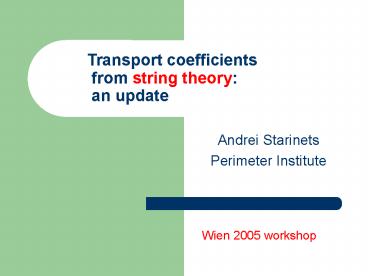Transport coefficients from string theory: an update - PowerPoint PPT Presentation
Title:
Transport coefficients from string theory: an update
Description:
Our goal is to understand thermal gauge theories, e.g. thermal QCD ... Gauge-gravity duality in string theory. Perturbative string theory: open and closed strings ... – PowerPoint PPT presentation
Number of Views:131
Avg rating:3.0/5.0
Title: Transport coefficients from string theory: an update
1
Transport coefficients
from string theory
an update
- Andrei Starinets
- Perimeter Institute
Wien 2005 workshop
2
Collaboration
Dam Son Giuseppe Policastro Chris Herzog Alvaro
Nunez Pavel Kovtun Alex Buchel Jim Liu Andrei
Parnachev Paolo Benincasa
References
hep-th/0205051 hep-th/0205052 hep-th/0302026
hep-th/0309213 hep-th/0405231
hep-th/0406124 hep-th/0506144 hep-th/0506184
hep-th/0507026
3
Prologue
- Our goal is to understand thermal gauge
theories, e.g. thermal QCD - Of particular interest is the regime described by
fluid dynamics, e.g. quark-gluon plasma - This near-equilibrium regime is completely
characterized by values of transport
coefficients, e.g. shear and bulk viscosity - Transport coefficients are hard to compute from
first principles, even in perturbation theory.
For example, no perturbative calculation of bulk
viscosity in gauge theory is available.
4
Prologue (continued)
- Transport coefficients of some gauge theories can
be computed in the regime described by string
(gravity) duals usually at large N and large t
Hooft coupling - Corrections can in principle be computed
- Shear viscosity result is universal.
Model-independent results may be of relevance for
RHIC physics - Certain results are predicted by hydrodynamics.
Finding them in gravity provides a check of the
AdS/CFT conjecture
5
Timeline and status report
- 2001 shear viscosity for N4 SYM computed
- 2002 prescription to compute thermal correlators
from gravity formulated and applied to N4 SYM
shear and sound poles in correlators are found - 2002-03 other poles in N4 SYM correlators
identified with quasinormal spectrum in gravity - 2003-04 universality of shear viscosity general
formula for diffusion coefficient from membrane
paradigm correction to shear viscosity - 2004-05 general prescription for computing
transport coefficients from gravity duals
formulated bulk viscosity and the speed of sound
computed in two non-conformal theories
equivalence between AdS/CFT and the membrane
paradigm formulas established spectral density
computed /preliminary/ - 2005-?? Nonzero chemical potential (with D.Son).
6
What is hydrodynamics?
Hierarchy of times (example)
0
t
Mechanical description
Kinetic theory
Hydrodynamic approximation
Equilibrium thermodynamics
Hierarchy of scales
(L is a macroscopic size of a system)
7
Holography and hydrodynamics
Gravitational fluctuations
Deviations from equilibrium
Dispersion relations
Quasinormal spectrum
8
Gauge-gravity duality in string theory
Perturbative string theory open and closed
strings (at low energy, gauge fields and gravity,
correspondingly)
Nonperturbative theory D-branes (topological
defects in 10d)
Complementary description of D-branes by open
(closed) strings
perturbative gauge theory description OK
perturbative gravity description OK
9
Hydrodynamics as an effective theory
Thermodynamic equilibrium
Near-equilibrium
Eigenmodes of the system of equations
Shear mode (transverse fluctuations of )
Sound mode
For CFT we have
and
10
Computing transport coefficients from first
principles
Fluctuation-dissipation theory (Callen, Welton,
Green, Kubo)
Kubo formulae allows one to calculate transport
coefficients from microscopic models
In the regime described by a gravity dual the
correlator can be computed using
AdS/CFT
11
Universality of
Theorem
For any thermal gauge theory (with zero
chemical potential), the ratio of shear
viscosity to entropy density is equal to
in the regime described by a corresponding
dual gravity theory
Remark
Gravity dual to QCD (if it exists at all) is
currently unknown.
12
Universality of shear viscosity in the regime
described by gravity duals
Gravitons component obeys equation for a
minimally coupled massless scalar. But then
.
Since the entropy (density) is
we get
13
Three roads to universality of
- The absorption argument
- D. Son, P. Kovtun, A.S., hep-th/0405231
- Direct computation of the correlator in Kubo
formula from AdS/CFT A.Buchel,
hep-th/0408095 - Membrane paradigm general formula for
diffusion coefficient interpretation as
lowest quasinormal frequency pole of the shear
mode correlator Buchel-Liu theorem - P. Kovtun, D.Son, A.S., hep-th/0309213,
A.S., to appear, - P.Kovtun, A.S., hep-th/0506184, A.Buchel,
J.Liu, hep-th/0311175
14
Shear viscosity in SYM
P.Arnold, G.Moore, L.Yaffe, 2001
Correction to A.Buchel, J.Liu,
A.S., hep-th/0406264
15
Viscosity of gases and liquids
Gases (Maxwell, 1867)
Viscosity of a gas is
- independent of pressure
- scales as square of temperature
- inversely proportional to cross-section
Liquids (Frenkel, 1926)
- W is the activation energy
- In practice, A and W are chosen to fit data
16
A viscosity bound conjecture
P.Kovtun, D.Son, A.S., hep-th/0309213,
hep-th/0405231
17
Two-point correlation function of stress-energy
tensor
Field theory
Zero temperature
Finite temperature
Dual gravity
- Five gauge-invariant combinations
- of and other fields determine
- obey a
system of coupled ODEs
- Their (quasinormal) spectrum determines
singularities - of the correlator
18
Classification of fluctuations and universality
O(2) symmetry in x-y plane
Shear channel
Sound channel
Scalar channel
Other fluctuations (e.g. )
may affect sound channel
But not the shear channel
universality of
19
Bulk viscosity and the speed of sound in
SYM
is a mass-deformed
(Pilch-Warner flow)
- Finite-temperature version A.Buchel, J.Liu,
hep-th/0305064
- The metric is known explicitly for
- Speed of sound and bulk viscosity
20
Relation to RHIC
- IF quark-gluon plasma is indeed formed in heavy
ion collisions
- IF a hydrodynamic regime is unambiguously proven
to exist
- THEN hydrodynamic MODELS describe experimental
results - for e.g. elliptic flows well, provided
- Bulk viscosity and speed of sound results are
- potentially interesting
21
Epilogue
- AdS/CFT gives insights into physics of thermal
gauge theories in the nonperturbative regime - Generic hydrodynamic predictions can be used to
check validity of AdS/CFT - General algorithm exists to compute transport
coefficients and the speed of sound in any
gravity dual - Model-independent statements can presumably be
checked experimentally
22
(No Transcript)
23
What is viscosity?
Friction in Newtons equation
Friction in Eulers equations































